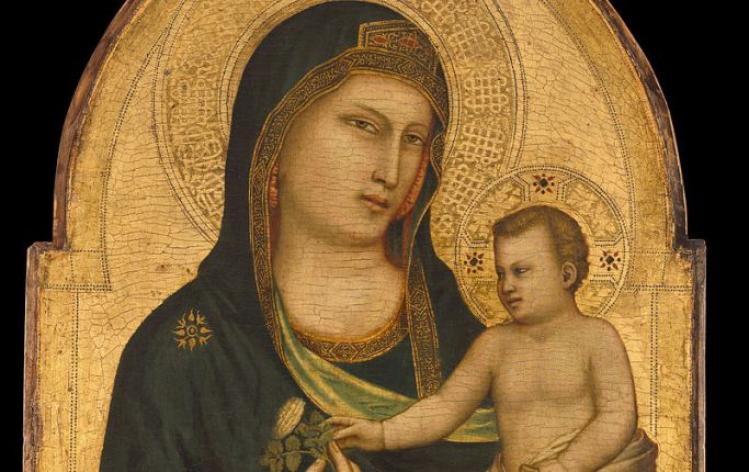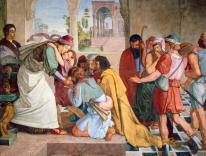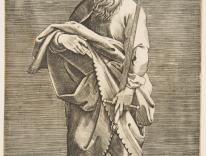
By agreeing to clothe the invisible God in human flesh, did Mary violate the biblical prohibition against creating idols? In the Second Commandment, God strictly forbade human beings from creating any “graven” or visible image of the invisible divine reality. Yet that is precisely what Mary accomplished through the Incarnation.
No theme is more dramatic and compelling in the history of Western art than the Annunciation. But the Annunciation is more than merely one popular subject of Christian art: the Annunciation is what makes any Christian art possible. Without the Incarnation, Christian art as we know it is unthinkable—note the striking absence of any Jewish or Islamic representational religious art.
Before the Incarnation, Jews were strictly forbidden by many biblical texts from any artistic representation of the divine Creator. Isaiah warns us that God’s thoughts and God’s ways are infinitely above our ways and our thoughts; Job is also terrifyingly reminded by the voice in the whirlwind not to reduce God’s justice to human dimensions. To make an image of God or even an image of one of his creatures, says the Second Commandment, is to make an idol. In our idols, we end up worshipping ourselves rather than the one true God.
The Bible teaches us, in short, that God is the one true creator. God is permitted to make his own image in us, but we must not attempt to imitate the divine prerogative. In Mary, God’s unique creative act becomes human procreation and the divine takes on visible form. We might think of her as the first Christian artist. The Incarnation authorizes human beings to create images of the divine reality. If the human body is a worthy home for the Almighty God, then surely it is a worthy subject of artistic representation.
Without the Incarnation, there would be no tradition of Christian representational art, from Giotto to Georges Rouault, not to mention the vast body of decorative art in churches. And yet, despite the Incarnation, Christian art continues to be a scandal in some quarters. For centuries, Christian artists felt constrained by the Second Commandment from depicting any divine reality except in the form of Jesus and the saints. Eastern Orthodox iconographers, for example, did not represent God the Father until the eighteenth century. The Holy Spirit could be represented only by a dove, as authorized by the New Testament.
And today, in the face of the widespread destruction of religious art by militant Islamic radicals, we would do well to remember the long history of Christian iconoclasm. Byzantine iconoclasts during the ninth century destroyed thousands of icons in the East—even forcing priests to eat their icons, just as Moses forced the Israelite idolaters to eat the Golden Calf. During the Protestant Reformation, Christian iconoclasts destroyed stained-glass windows, paintings, and sculptures all over Western Europe.
Calvinist iconoclasts also attacked many of the traditional Catholic sacraments. A sacrament, after all, is a visible sign of an invisible divine grace, just as is Christian art. Catholic sacraments and sacramentals were regarded by Reforming iconoclasts as idols to be smashed. There is no doubt that sacramentals can lead to superstition and that art can create idols. It is always dangerous to render the invisible visible, to shrink the infinite to a human scale. But Christian art, while revered, is never meant to be worshipped. Like the sacraments, Christian art leads us to the divine source of beauty, just as stained-glass windows lead us to the light.
I live in Northern New England, in the heart of colonial Calvinist Christianity. Our Congregational churches are shorn of all representational art, even of the Crucifixion. Yet I find myself deeply moved by the clean simplicity of the worship space and, with no art to view, I am drawn to inward reflection. Visiting one such church with a Polish friend, I contrasted this style with the extravagantly ornate churches in Krakow, teeming with statues and icons. Yet, my friend Tomek told me: “Perhaps we should adorn our hearts rather than our churches.” True, but I believe that the contemplation of Christian art can also serve to adorn our hearts.
The iconoclasts are right: we are indeed prone to put our faith and trust in human constructs. But the most dangerous idols have not been statues or icons. Our Golden Calves have ranged from money and nationalism to sectarian theological doctrines—even the seductive ideal of Christendom itself.
Please email comments to [email protected] and join the conversation on our Facebook page.
Share
Previous Story
Happy Holidays, Donald Trump...
Next Story
A Tale of Four Cardinals

